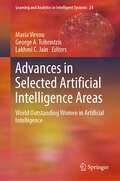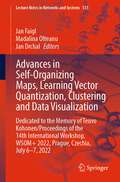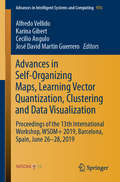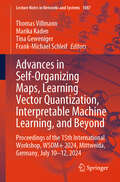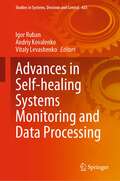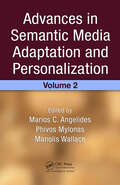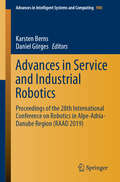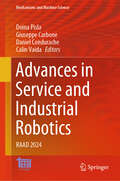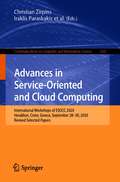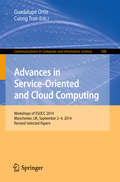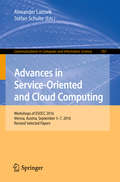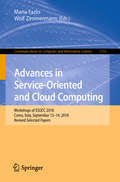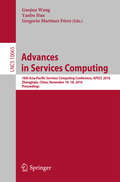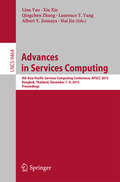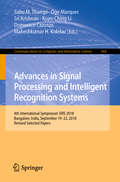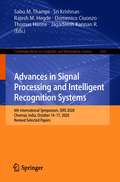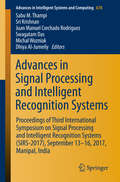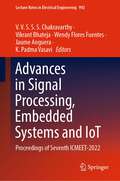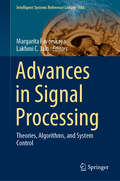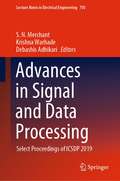- Table View
- List View
Advances in Selected Artificial Intelligence Areas: World Outstanding Women in Artificial Intelligence (Learning and Analytics in Intelligent Systems #24)
by Lakhmi C. Jain Maria Virvou George A. TsihrintzisAs new technological challenges are perpetually arising, Artificial Intelligence research interests are focusing on the incorporation of improvement abilities into machines in an effort to make them more efficient and more useful. Recent reports indicate that the demand for scientists with Artificial Intelligence skills significantly exceeds the market availability and that this shortage will intensify further in the years to come. A potential solution includes attracting more women into the field, as women currently make up only 26 percent of Artificial Intelligence positions in the workforce. The present book serves a dual purpose: On one hand, it sheds light on the very significant research led by women in areas of Artificial Intelligence, in hopes of inspiring other women to follow studies in the area and get involved in related research. On the other hand, it highlights the state-of-the-art and current research in selected Artificial Intelligence areas and applications. The book consists of an editorial note and an additional thirteen (13) chapters, all authored by invited women-researchers who work on various Artificial Intelligence areas and stand out for their significant research contributions. In more detail, the chapters in the book are organized into three parts, namely (i) Advances in Artificial Intelligence Paradigms, (ii) Advances in Artificial Intelligence Applications, and (iii) Recent Trends in Artificial Intelligence Areas and Applications. This research book is directed towards professors, researchers, scientists, engineers and students in Artificial Intelligence-related disciplines. It is also directed towards readers who come from other disciplines and are interested in becoming versed in some of the most recent Artificial Intelligence-based technologies. An extensive list of bibliographic references at the end of each chapter guides the readers to probe further into the Artificial Intelligence areas of interest to them.
Advances in Self-Organizing Maps and Learning Vector Quantization: Proceedings of the 11th International Workshop WSOM 2016, Houston, Texas, USA, January 6-8, 2016 (Advances in Intelligent Systems and Computing #428)
by Erzsébet Merényi Michael J. Mendenhall Patrick O'DriscollThis book contains the articles from the international conference 11th Workshop on Self-Organizing Maps 2016 (WSOM 2016), held at Rice University in Houston, Texas, 6-8 January 2016. WSOM is a biennial international conference series starting with WSOM'97 in Helsinki, Finland, under the guidance and direction of Professor Tuevo Kohonen (Emeritus Professor, Academy of Finland). WSOM brings together the state-of-the-art theory and applications in Competitive Learning Neural Networks: SOMs, LVQs and related paradigms of unsupervised and supervised vector quantization. The current proceedings present the expert body of knowledge of 93 authors from 15 countries in 31 peer reviewed contributions. It includes papers and abstracts from the WSOM 2016 invited speakers representing leading researchers in the theory and real-world applications of Self-Organizing Maps and Learning Vector Quantization: Professor Marie Cottrell (Universite Paris 1 Pantheon Sorbonne, France), Professor Pablo Estevez (University of Chile and Millennium Instituteof Astrophysics, Chile), and Professor Risto Miikkulainen (University of Texas at Austin, USA). The book comprises a diverse set of theoretical works on Self-Organizing Maps, Neural Gas, Learning Vector Quantization and related topics, and an excellent variety of applications to data visualization, clustering, classification, language processing, robotic control, planning, and to the analysis of astronomical data, brain images, clinical data, time series, and agricultural data.
Advances in Self-Organizing Maps, Learning Vector Quantization, Clustering and Data Visualization: Dedicated to the Memory of Teuvo Kohonen / Proceedings of the 14th International Workshop, WSOM+ 2022, Prague, Czechia, July 6-7, 2022 (Lecture Notes in Networks and Systems #533)
by Jan Faigl Madalina Olteanu Jan DrchalIn this collection, the reader can find recent advancements in self-organizing maps (SOMs) and learning vector quantization (LVQ), including progressive ideas on exploiting features of parallel computing. The collection is balanced in presenting novel theoretical contributions with applied results in traditional fields of SOMs, such as visualization problems and data analysis. Besides, the collection further includes less traditional deployments in trajectory clustering and recent results on exploiting quantum computation. The presented book is worth interest to data analysis and machine learning researchers and practitioners, specifically those interested in being updated with current developments in unsupervised learning, data visualization, and self-organization.
Advances in Self-Organizing Maps, Learning Vector Quantization, Clustering and Data Visualization: Proceedings of the 13th International Workshop, WSOM+ 2019, Barcelona, Spain, June 26-28, 2019 (Advances in Intelligent Systems and Computing #976)
by Alfredo Vellido Karina Gibert Cecilio Angulo José David Martín GuerreroThis book gathers papers presented at the 13th International Workshop on Self-Organizing Maps, Learning Vector Quantization, Clustering and Data Visualization (WSOM+), which was held in Barcelona, Spain, from the 26th to the 28th of June 2019. Since being founded in 1997, the conference has showcased the state of the art in unsupervised machine learning methods related to the successful and widely used self-organizing map (SOM) method, and extending its scope to clustering and data visualization. In this installment of the AISC series, the reader will find theoretical research on SOM, LVQ and related methods, as well as numerous applications to problems in fields ranging from business and engineering to the life sciences. Given the scope of its coverage, the book will be of interest to machine learning researchers and practitioners in general and, more specifically, to those looking for the latest developments in unsupervised learning and data visualization.
Advances in Self-Organizing Maps, Learning Vector Quantization, Interpretable Machine Learning, and Beyond: Proceedings of the 15th International Workshop, WSOM+ 2024, Mittweida, Germany, July 10–12, 2024 (Lecture Notes in Networks and Systems #1087)
by Thomas Villmann Frank-Michael Schleif Marika Kaden Tina GewenigerThe book presents the peer-reviewed contributions of the 15th International Workshop on Self-Organizing Maps, Learning Vector Quantization and Beyond (WSOM$+$ 2024), held at the University of Applied Sciences Mittweida (UAS Mitt\-weida), Germany, on July 10–12, 2024. The book highlights new developments in the field of interpretable and explainable machine learning for classification tasks, data compression and visualization. Thereby, the main focus is on prototype-based methods with inherent interpretability, computational sparseness and robustness making them as favorite methods for advanced machine learning tasks in a wide variety of applications ranging from biomedicine, space science, engineering to economics and social sciences, for example. The flexibility and simplicity of those approaches also allow the integration of modern aspects such as deep architectures, probabilistic methods and reasoning as well as relevance learning. The book reflects both new theoretical aspects in this research area and interesting application cases. Thus, this book is recommended for researchers and practitioners in data analytics and machine learning, especially those who are interested in the latest developments in interpretable and robust unsupervised learning, data visualization, classification and self-organization.
Advances in Self-healing Systems Monitoring and Data Processing (Studies in Systems, Decision and Control #425)
by Igor Ruban Vitaly Levashenko Andriy KovalenkoThis book presents the systematized research, development and improvement of methods in self-healing communication and control systems. The book presents new models and methods of data processing, focused on the specifics of self-healing systems. The goal is to equip the reader with the necessary knowledge about trends in monitoring and detecting failures, modelling processes and methods of data processing in self-healing communication and control systems.
Advances in Semantic Media Adaptation and Personalization, Volume 2
by Marios C. Angelides Manolis Wallace Phivos MylonasThe emergence of content- and context-aware search engines, which not only personalize searching and delivery but also the content, has caused the emergence of new infrastructures capable of end-to-end ubiquitous transmission of personalized multimedia content to any device on any network at any time. Personalizing and adapting content requires pro
Advances in Service Science: Proceedings of the 2018 INFORMS International Conference on Service Science (Springer Proceedings in Business and Economics)
by Hui Yang Robin QiuThis volume offers the state-of-the-art research and developments in service science and related research, education and practice areas. It showcases emerging technology and applications in fields including healthcare, information technology, transportation, sports, logistics, and public services. Regardless of size and service, a service organization is a service system. Because of the socio-technical nature of a service system, a systems approach must be adopted to design, develop, and deliver services, aimed at meeting end users' both utilitarian and socio-psychological needs. Effective understanding of service and service systems often requires combining multiple methods to consider how interactions of people, technology, organizations, and information create value under various conditions. The papers in this volume highlight ways to approach such technical challenges in service science and are based on submissions from the 2018 INFORMS International Conference on Service Science.
Advances in Service and Industrial Robotics: Proceedings of the 28th International Conference on Robotics in Alpe-Adria-Danube Region (RAAD 2019) (Advances in Intelligent Systems and Computing #980)
by Karsten Berns Daniel GörgesThis book presents the proceedings of the 28th International Conference on Robotics in Alpe-Adria-Danube Region, RAAD 2019, held at the Fraunhofer Zentrum and the Technische Universität in Kaiserslautern, Germany, on 19–21 June 2019. The conference brought together academic researchers in robotics from 20 countries, mainly affiliated to the Alpe-Adria-Danube Region and covered all major areas of robotic research, development and innovation as well as new applications and current trends. Offering a comprehensive overview of the ongoing research in the field of robotics, the book is a source of information and inspiration for researchers wanting to improve their work and gather new ideas for future developments. It also provides researchers with an innovative and up-to-date perspective on the state of the art in this area.
Advances in Service and Industrial Robotics: RAAD 2024 (Mechanisms and Machine Science #157)
by Giuseppe Carbone Doina Pisla Calin Vaida Daniel ConduracheThis book presents the Proceedings of the 33rd International Conference on Robotics in Alpe-Adria-Danube Region (RAAD), held in Cluj-Napoca, Romania, June 5–7, 2024. It gathers contributions by researchers from multiple countries on all major areas of robotic research, development, and innovation, as well as new applications and current trends. The topics include perception and learning, medical robotics and biomechanics, industrial robots and education, kinematics and dynamics, motion planning and control, service robotics and applications, mobile robots and innovative robot design, etc. Given its scope, the book offers a source of information and inspiration for researchers seeking to improve their work and gather new ideas for future developments.
Advances in Service-Oriented and Cloud Computing: International Workshops of ESOCC 2020, Heraklion, Crete, Greece, September 28–30, 2020, Revised Selected Papers (Communications in Computer and Information Science #1360)
by Guadalupe Ortiz Winfried Lamersdorf Massimo Villari Claus Pahl Pierluigi Plebani Christian Zirpins Iraklis Paraskakis Vasilios Andrikopoulos Nane Kratzke Nabil El Ioini Andreas S. Andreou George Feuerlicht Willem-Jan Van den Heuvel Jacopo Soldani Giuliano CasaleThis volume contains the technical papers presented in the workshops, PhD Symposium and EU Projects Track which took place at the 8th European Conference on Service-Oriented and Cloud Computing, ESOCC 2020, held in Heraklion, Crete, Greece, in September 2020: 1st International Workshop on Edge Adoption and Migration, EdgeWays 2020, 16th International Workshop on Engineering Service-Oriented Applications and Cloud Services, WESOACS 2020, ESOCC 2020 PhD Symposium, ESOCC 2020 EU Projects Track. Due to the COVID-19 pandemic the conference and workshops were held in a virtual format. The 17 full papers and 2 short papers were reviewed and selected from 22 submissions. The papers focus on specific topics in service-oriented and cloud computing domains such as limits and/or advantages of existing cloud solutions, future internet technologies, efficient and adaptive deployment and management of service-based applications across multiple clouds, novel cloud service migration practices and solutions, digitization of enterprises in the cloud computing era, federated cloud networking services.
Advances in Service-Oriented and Cloud Computing: International Workshops of ESOCC 2022, Wittenberg, Germany, March 22–24, 2022, Revised Selected Papers (Communications in Computer and Information Science #1617)
by Guadalupe Ortiz Massimo Villari Christian Zirpins Jacopo Soldani Zoltan Nochta Oliver Waldhorst Damian TamburriThis volume contains the technical papers presented in the workshops, which took place at the 9th European Conference on Service-Oriented and Cloud Computing, ESOCC 2022, held in Wittenberg, Germany, in March 2022.The 4 full papers and 7 short papers included in these proceedings were carefully reviewed and selected from 17 submissions. The workshop proceedings volume of ESOCC 2022 contains contributions from the following workshops and events:First International Workshop on AI for Web Application Infrastructure and Cloud Platform Security (AWACS 2022)PhD Symposium of ESOCC 2022ESOCC 2022 Projects TrackESOCC 2022 Industrial Track
Advances in Service-Oriented and Cloud Computing: Workshops of ESOCC 2014, Manchester, UK, September 2-4, 2014, Revised Selected Papers (Communications in Computer and Information Science #508)
by Guadalupe Ortiz Cuong TranThis volume contains the technical papers presented in the four high-quality workshops associated with the European Conference on Service-Oriented and Cloud Computing, ESOCC 2014, held in Manchester, UK, in September 2014: 4th International Workshop on Adaptive Services for the Future Internet, WAS4FI 2014, 2nd International Workshop on Cloud for IoT, CLIoT 2014, 2nd International Workshop on Cloud Service Brokerage, CSB 2014, and Seamless Adaptive Multi-cloud Management of Service-based Applications, SeaCloudS Workshop. The 19 revised full papers and 3 short papers were carefully reviewed and selected from 39 submissions. They focus on specific topics in service-oriented and cloud computing domains as cloud computing, service buses, Web services, service-oriented architectures, event-driven architectures, enterprise architectures, business process management, software selection and adaptation.
Advances in Service-Oriented and Cloud Computing: Workshops of ESOCC 2015, Taormina, Italy, September 15-17, 2015, Revised Selected Papers (Communications in Computer and Information Science #567)
by Antonio Celesti Philipp LeitnerThis volume contains the technical papers presented in the seven high-quality workshops associated with the European Conference on Service-Oriented and Cloud Computing, ESOCC 2015, held in Taormina, Italy, in September 2015: Third International Workshop on Cloud for IoT (CLloT 2015), 5th International Workshop on Adaptive Services for the Future Internet (WAS4FI 2015), Second Workshop on Seamless Adaptive Multi-cloud Management of Service-Based Applications (SeaClouds 2015), First International Workshop on Cloud Adoption and Migration (CloudWay 2015), First International Workshop on Digital Enterprise Architecture and Engineering (IDEA 2015), First Workshop on Federated Cloud Networking (FedCloudNet 2015). Abstracts of the presentations held at the European Projects Forum (EU Projects 2015) are included in the back matter of this volume. The 25 full papers and 6 short papers were carefully reviewed and selected from 48 submissions. They focus on specific topics in service-oriented and cloud computing domains such as limits and /or advantages of existing cloud solutions, Future Internet technologies, efficient and adaptive deployment and management of service-based applications across multiple clouds, novel cloud service migration practices and solutions, digitization of enterprises in the cloud computing era, federated cloud networking services.
Advances in Service-Oriented and Cloud Computing: Workshops of ESOCC 2016, Vienna, Austria, September 5–7, 2016, Revised Selected Papers (Communications in Computer and Information Science #707)
by Stefan Schulte Alexander LazovikThis volume contains the technical papers presented in the workshops associated with the European Conference on Service-Oriented and Cloud Computing, ESOCC 2016, held in Vienna, Austria, in September 2016: 4th International Workshop on Cloud for IoT, CLloT 2016, Second International Workshop on Cloud Adoption and Migration, CloudWays 2016, First International Workshop on Patterns and Pattern Languages for SOCC: Use and Discovery, PATTWORLD 2016, combined with the First International Workshop on Performance and Conformance of Workflow Engines, PEaCE 2016, IFIP WG SOS Workshop 2016 Rethinking Services ResearCH, ReSeRCH 2016. Furthermore, there is a topical section presenting the results of the PhD Symposium. The abstracts of the presentations held at the European Projects Forum, EU Projects 2016, are included in the back-matter of the volume. The 15 full papers included in this volume were carefully reviewed and selected from 49 submissions. They focus on specific topics in service-oriented and cloud computing domains such as limits and/or advantages of existing cloud solutions, future internet technologies, efficient and adaptive deployment and management of service-based applications across multiple clouds, novel cloud service migration practices and solutions, digitization of enterprises in the cloud computing era, federated cloud networking services.
Advances in Service-Oriented and Cloud Computing: Workshops of ESOCC 2018, Como, Italy, September 12–14, 2018, Revised Selected Papers (Communications in Computer and Information Science #1115)
by Maria Fazio Wolf ZimmermannThis volume contains the technical papers presented in the workshops, which took place at the 7th European Conference on Service-Oriented and Cloud Computing, ESOCC 2018, held in Como, Italy, in September 2018:Joint Cloudways and OptiMoCS Workshop; 14th International Workshop on Engineering Service-Oriented Applications and Cloud Services. Additionally the papers from ESOCC 2018 PhD Symposium and ESOCC 2018 EU Projects Track were included in the volume. The 22 full papers were carefully reviewed and selected from 34 submissions. The papers focus on specific topics in service-oriented and cloud computing domains such as limits and/or advantages of existing cloud solutions, future internet technologies, efficient and adaptive deployment and management of service-based applications across multiple clouds, novel cloud service migration practices and solutions, digitization of enterprises in the cloud computing era, federated cloud networking services.
Advances in Services Computing: 10th Asia-Pacific Services Computing Conference, APSCC 2016, Zhangjiajie, China, November 16-18, 2016, Proceedings (Lecture Notes in Computer Science #10065)
by Guojun Wang Yanbo Han Gregorio Martínez PérezThis book constitutes the refereed proceedings of the 10th Asia-Pacific Services Computing Conference, APSCC 2016, held in Zhangjiajie, China, in November 2016. The 38 revised full papers presented in this book were carefully reviewed and selected from 107 submissions. The papers cover a wide range of topics in the fields of cloud/utility/Web computing/big data; foundations of services computing; social/peer-to-peer/mobile/ubiquitous/pervasive computing; service-centric computing models; integration of telecommunication SOA and Web services; business process integration and management; and security in services.
Advances in Services Computing: 9th Asia-Pacific Services Computing Conference, APSCC 2015, Bangkok, Thailand, December 7-9, 2015, Proceedings (Lecture Notes in Computer Science #9464)
by Albert Y. Zomaya Lina Yao Xia Xie Qingchen Zhang Laurence T. Yang Hai JinThis book constitutes the refereed proceedings of the 9th Asia-Pacific Services Computing Conference, APSCC 2015, held in Bangkok, Thailand, in December 2015. The 17 revised full papers and 6 short papers presented were carefully reviewed and selected from numerous submissions. The papers cover a wide range of topics in services computing, web services, cloud computing, security in services, and social, peer-to-peer, mobile, ubiquitous and pervasive computing.
Advances in Signal Processing and Intelligent Recognition Systems: 4th International Symposium SIRS 2018, Bangalore, India, September 19–22, 2018, Revised Selected Papers (Communications in Computer and Information Science #968)
by Oge Marques Kuan-Ching Li Sabu M. Thampi Sri Krishnan Domenico Ciuonzo Maheshkumar H. KolekarThis book constitutes the refereed proceedings of the 4th International Symposium on Advances in Signal Processing and Intelligent Recognition Systems, SIRS 2018, held in Bangalore, India, in September 2018.The 28 revised full papers and 11 revised short papers presented were carefully reviewed and selected from 92 submissions. The papers cover wide research fields including information retrieval, human-computer interaction (HCI), information extraction, speech recognition.
Advances in Signal Processing and Intelligent Recognition Systems: 5th International Symposium, SIRS 2019, Trivandrum, India, December 18–21, 2019, Revised Selected Papers (Communications in Computer and Information Science #1209)
by Oge Marques Selwyn Piramuthu Sabu M. Thampi Juan M. Corchado Sri Krishnan Jayanta Mukhopadhyay Rajesh M. Hegde Vipin ChaudharyThis book constitutes the refereed proceedings of the 5th International Symposium on Advances in Signal Processing and Intelligent Recognition Systems, SIRS 2019, held in Trivandrum, India, in December 2019. The 19 revised full papers and 8 revised short papers presented were carefully reviewed and selected from 63 submissions. The papers cover wide research fields including information retrieval, human-computer interaction (HCI), information extraction, speech recognition.
Advances in Signal Processing and Intelligent Recognition Systems: 6th International Symposium, SIRS 2020, Chennai, India, October 14–17, 2020, Revised Selected Papers (Communications in Computer and Information Science #1365)
by Thomas Hanne Sabu M. Thampi Sri Krishnan Domenico Ciuonzo Rajesh M. Hegde Jagadeesh Kannan R.This book constitutes the refereed proceedings of the 6th International Symposium on Advances in Signal Processing and Intelligent Recognition Systems, SIRS 2020, held in Chennai, India, in October 2020. Due to the COVID-19 pandemic the conference was held online. The 22 revised full papers and 5 revised short papers presented were carefully reviewed and selected from 50 submissions. The papers cover wide research fields including information retrieval, human-computer interaction (HCI), information extraction, speech recognition.
Advances in Signal Processing and Intelligent Recognition Systems: Proceedings of Third International Symposium on Signal Processing and Intelligent Recognition Systems (SIRS-2017), September 13-16, 2017, Manipal, India (Advances in Intelligent Systems and Computing #678)
by Swagatam Das Sabu M. Thampi Michal Wozniak Sri Krishnan Juan Manuel Corchado Rodriguez Dhiya Al-JumeilyThis edited volume contains a selection of refereed and revised papers originally presented at the International Symposium on Signal Processing and Intelligent Recognition Systems (SIRS-2014), March 13-15, 2014, Trivandrum, India. The program committee received 134 submissions from 11 countries. Each paper was peer reviewed by at least three or more independent referees of the program committee and the 52 papers were finally selected. The papers offer stimulating insights into Pattern Recognition, Machine Learning and Knowledge-Based Systems; Signal and Speech Processing; Image and Video Processing; Mobile Computing and Applications and Computer Vision. The book is directed to the researchers and scientists engaged in various field of signal processing and related areas.
Advances in Signal Processing, Embedded Systems and IoT: Proceedings of Seventh ICMEET- 2022 (Lecture Notes in Electrical Engineering #992)
by Vikrant Bhateja Jaume Anguera V. V. S. S. S. Chakravarthy Wendy Flores Fuentes K. Padma VasaviThe book discusses the latest developments and outlines future trends in the fields of microelectronics, electromagnetics and telecommunication. It contains original research works presented at the International Conference on Microelectronics, Electromagnetics and Telecommunication (ICMEET 2022), held in Bheemavaram, West Godavari (Dist), Andhra Pradesh, India during 22 – 23 July 2022. The papers were written by scientists, research scholars and practitioners from leading universities, engineering colleges and R&D institutes from all over the world, and share the latest breakthroughs in and promising solutions to the most important issues facing today’s society.
Advances in Signal Processing: Theories, Algorithms, and System Control (Intelligent Systems Reference Library #184)
by Lakhmi C. Jain Margarita FavorskayaThis book attempts to improve algorithms by novel theories and complex data analysis in different scopes including object detection, remote sensing, data transmission, data fusion, gesture recognition, and medical image processing and analysis.The book is directed to the Ph.D. students, professors, researchers, and software developers working in the areas of digital video processing and computer vision technologies.
Advances in Signal and Data Processing: Select Proceedings of ICSDP 2019 (Lecture Notes in Electrical Engineering #703)
by S. N. Merchant Krishna Warhade Debashis AdhikariThis book presents the select peer-reviewed proceedings of the International Conference on Signal and Data Processing (ICSDP) 2019. It examines and deliberates on the recent progresses in the areas of communication and signal processing. The book includes topics on the recent advances in the areas of wired and wireless communication, low complexity architecture of MIMO receivers, applications on wireless sensor networks and internet of things, signal processing, image processing and computer vision, VLSI embedded systems, cognitive networks, power electronics and automation, mechatronics based applications, systems and control, cognitive science and machine intelligence, information security and big data. The contents of this book will be useful for beginners, researchers, and professionals interested in the area of communication, signal processing, and allied fields.
